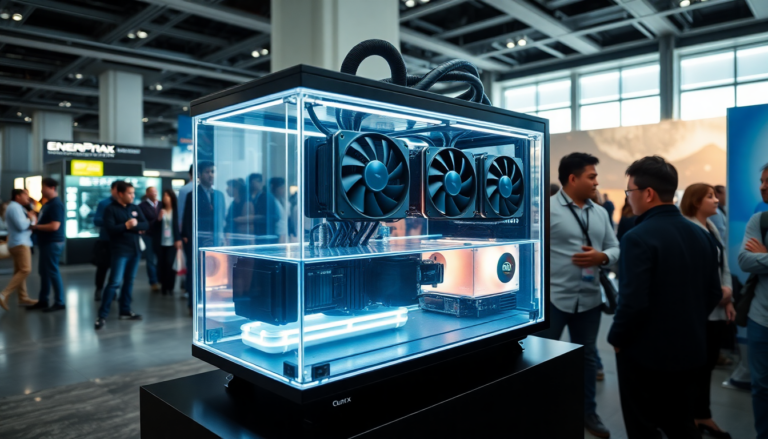Argomenti trattati
The world of high-performance computing never ceases to amaze, and at Computex 2025, Enermax took the stage with a jaw-dropping demonstration of its latest innovation: a $50,000 immersion-cooled system. With four RTX 4090 GPUs and two powerful 2400-watt power supplies, this setup isn’t just for your average gamer—it’s a glimpse into the future of PC hardware. But what does it really mean for tech enthusiasts and the industry at large?
Breaking down immersion cooling technology
Heat has long been the nemesis of high-performance PCs, especially as hardware becomes increasingly powerful. The Cirrus Mk1 from Enermax tackles this issue head-on using two-phase liquid immersion cooling. This technology effectively transfers heat away from vital components (think processors and GPUs) to an external heat exchanger, thereby maintaining optimal temperatures even under heavy loads. Imagine a system capable of handling up to 3,300 watts of power—this isn’t just a cooling solution; it’s a revolution.
To illustrate its capabilities, the demo system featured an AMD Ryzen Threadripper 7960X processor alongside four GeForce RTX 5090 GPUs, all mounted on a Gigabyte TRX50 AI-TOP motherboard. It’s like watching a well-oiled machine perform at its best, yet the price tag is enough to make most enthusiasts gasp. Personally, I believe that while such innovations are fascinating, the accessibility of these technologies remains a question. How many are willing to fork out that kind of cash for thermal efficiency?
Kioxia’s optical SSD advancements
While Enermax was stirring excitement with its cooling solutions, Kioxia was busy pushing the envelope with optical SSD technology. Demonstrated with Kyocera’s Optinity PCIe cards, Kioxia aims to make optical storage more mainstream. Their setup showcased an impressive feat: an optical connection delivering performance identical to traditional electrical connections over a distance of 30 meters.
This not only highlights the potential for longer and more reliable connections in challenging environments but also raises the stakes for data transfer speeds. I remember when solid-state drives were the new frontier, and now we’re talking about optical connections that could redefine speed benchmarks. It’s thrilling and a bit daunting to think how quickly technology evolves.
Handheld gaming PCs: The next frontier
The handheld gaming scene continues to explode, and I can’t help but feel a tingle of nostalgia for those days spent huddled over a Game Boy. With the impending release of the Nintendo Switch 2, interest in handheld devices is bound to spike. Zotac’s latest offering, the Zone 2, is a notable contender, featuring an AMD Ryzen AI 9 HX 370 processor, a 7-inch 1080p display with a 120 Hz refresh rate, and a robust 1TB PCIe 4.0 SSD.
This device isn’t just a gaming machine; it runs on Manjaro Linux with KDE Plasma 6, ensuring compatibility with a broad spectrum of games via Proton. One can only wonder—are we witnessing the dawn of a new era in gaming where powerful, portable devices become the norm? Honestly, I can’t wait to see where this trend leads us.
Memory advancements by G.Skill
If you’ve been keeping an eye on DDR5 memory, G.Skill is making waves with some astonishing setups. Their recent showcase included a 2x 24GB DDR5 configuration achieving speeds of 10,934 MT/s. Coupled with an ASUS ROG Maximus Z890 APEX motherboard, this is performance that’s hard to ignore.
For those more concerned with capacity than raw speed, they displayed an impressive eight 64GB R-DIMM DDR5-6600 CL42 configuration, totaling a whopping 512GB. It’s a staggering amount of memory—perfect for data-heavy tasks or, let’s be honest, for those who simply want the bragging rights that come with such a setup. As someone who appreciates the delicate balance between performance and capacity, I can’t help but be excited about what this means for future computing endeavors.
As we delve deeper into the world of high-tech innovations showcased at Computex, one thing is clear: the boundaries of technology are continually being pushed. Whether it’s Enermax’s extravagant immersion cooling systems, Kioxia’s optical SSDs, or G.Skill’s memory advancements, the future is bright (and perhaps a bit expensive) for tech enthusiasts everywhere. And who knows? Maybe one day, these cutting-edge technologies will become standard in every gaming rig, paving the way for an entirely new era of computing.

